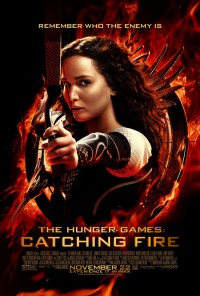 As a fan of the book trilogy, and now that we’re halfway through the series, I can confidently say the Hunger Games books are turning into even better films. And while the first film, The Hunger Games, was a good film with a handful of flaws, The Hunger Games: Catching Fire is an example of exemplary filmmaking. This isn’t just an example of what sequels should be, it’s an example of what movies should be.
As a fan of the book trilogy, and now that we’re halfway through the series, I can confidently say the Hunger Games books are turning into even better films. And while the first film, The Hunger Games, was a good film with a handful of flaws, The Hunger Games: Catching Fire is an example of exemplary filmmaking. This isn’t just an example of what sequels should be, it’s an example of what movies should be.
Catching Fire picks up roughly a year after the first film. Katniss (Jennifer Lawrence) and Peeta (Josh Hutcherson) live in a state of constant turmoil in their impoverished District Twelve. Though there is little feeling between them, they are forced to enact a love affair for the cameras and the people. Meanwhile, a revolution is brewing in the nation of Panem, for which Katniss’ real crush, Gale (Liam Hemsworth), wants to be a part of. After the victory tour, where the two victors are marched from district to district to remind their peoples of their losses, Katniss and Peeta are once again drawn into the Hunger Games in the deadly Quarter Quell, where past victors are chosen to compete against one another.
A lot happens in this second installment, but unlike the first film it never takes too long to explain or never comes off as rushed. The pacing is greatly improved, streamlined for a film audience. The action moves along at a brisk pace, and the emotions are better defined. Whereas the first film’s grab was in children killing each other—often kept remarkably off-camera—this film strikes you with watching people who have already been through hell being forced to go through it again. Remarkably, as emotionally gripping as the film is, Francis Lawrence (Constantine, I Am Legend) doesn’t beat the audience over the head. He doesn’t fight for tears, he lets them happen. A truly sad scene in the book is given the minimum screen time in the film, but it’s affecting nonetheless. This is how you know you’ve crafted something good.
The one constant between the two films is the superb quality of the acting. Jennifer Lawrence, as always, shines in the lead role. She is strong and determined, but at the same time displays weakness and insecurity. She shows obvious signs of PTSD and makes us truly believe that she is stuck between loving Gale and Peeta. The turmoil in her is real, and whereas in the book she begins to come off as an awkward, poorly-written caricature, in the film she is a believable martyr. Josh Hutcherson comes into his own as Peeta; he is no longer the puppy dog wanting a treat, but he is a strong character who stands behind Katniss, regardless of her true feelings to him. The rest of the cast is also given more room to shine: Liam Hemsworth, Woody Harrelson, Elizabeth Banks, and the other competitors in the Quarter Quell fill their roles with such depth it’s amazing. And Donald Sutherland, even more than in the first film, oozes dread and elicits the same reaction as Darth Vader would.
This film technically excels where the first one fell short. The cinematography is much steadier, giving flow to the action; the first one gave you urgency but not clarity, but this one manages to do both with a more fluid shot style. The tone is also darker: shadows and blues dominate, and bright colors flare when needed—particularly when it comes to the revolution and the red Mockingjay symbol. The effects are also par none. One needs to look no further than to compare the fire suits from the first film to those in this one.
After watching Catching Fire, I felt the same was as watching the first few Harry Potter films. The first movie was set-up: it was reverential in the way it followed the text, replicating dialogue and scenes verbatim, whether or not they worked on film. And for this both films were good, but not great. They functioned.
Catching Fire is like Harry Potter and the Prisoner of Azkaban (or, in other ways, The Empire Strikes Back). The series has truly come into its own.
For more information visit: http://www.imdb.com/title/tt1951264/combined